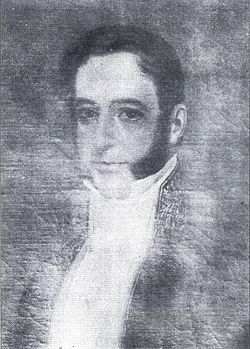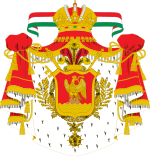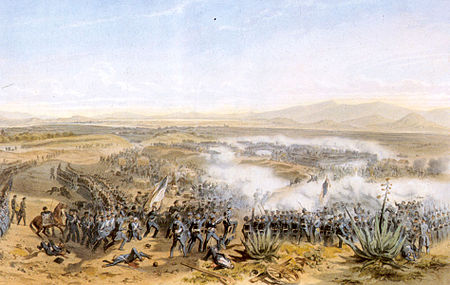- Agustín Jerónimo de Iturbide y Huarte
-
This name uses Spanish naming customs; the first or paternal family name is Iturbide and the second or maternal family name is Huarte.
Agustín Jerónimo Prince Imperial of Mexico 
The only known image of the Prince Imperial. Full name Agustín Jerónimo de Iturbide y Huarte House House of Iturbide Father Agustín de Iturbide Mother Ana María de Huarte y Muñiz Born 30 September 1807
Valladolid, Michoacán, New Spain
Died 11 November 1866 (aged 59)
New York, New York, United States
Burial Roman Catholic Church of St John the Evangelist, Philadelphia, Pennsylvania Religion Roman Catholicism Monarchical styles of
Agustín Jerónimo, Prince Imperial
Reference style His Imperial Highness Spoken style Your Imperial Highness Alternative style Sire Don Agustín Jerónimo de Iturbide y Huarte, Prince Imperial of Mexico, OG OME (30 September 1807 - 11 November 1866) was the son of the first Mexican Emperor Agustín I of Mexico, the heir apparent to the First Mexican Empire and a member of the Imperial House of Iturbide; later in his life he served as a military officer in South America and also worked as a diplomat for the United Mexican States at the Mexican embassy in the United States and in London after his military career had ended in South America.[1]
Contents
Birth and early life
Agustín Jerónimo de Iturbide y Huarte was born in the city of Valladolid in the state of Michoacán in New Spain. His parents, Agustín de Iturbide and Ana María de Huarte y Muñiz, were Spanish-Basque aristocrats and owed large tracts of farmland,[2][3] the two haciendas of Apeo and Guaracha as well as more land in nearby Quirio.[4] Agustín had several other siblings, including:
- Sabina de Iturbide y Huarte
- Juana María de Itrubide y Muñiz
- Josefa de Iturbide y Huarte
- Ángel de Iturbide y Huarte
- Jesus de Iturbide y Huarte
- María de Jesus de Iturbide y Huarte
- María de los Dolores de Iturbide y Huarte
- Salvador de Iturbide y Huarte
- Felipe Andrés María Guadalupe de Iturbide y Huarte
- Agustín Cosme de Iturbide y Huarte
He spent his early years with his mother and other siblings on their two haciendas as his father was fighting in the Mexican War of Independence and was little at home with his children. Eventually he was able to build a successful military and political coalition and managed to capture Mexico City on 27 September 1821, decisively ending the war.[5] On 19 May 1822 his father was elected Emperor of Mexico by the Mexican Congress, young Agustín reportedly became so dizzy he could hardly stand when he heard the news of his father's election as emperor of the new nation.[6][7]
Only three days later on 22 June 1822, the young Agustín was made heir apparent to the throne with the title of Prince Imperial of Mexico which came with the style of Imperial Highness and the honorific title of "Don". All his other siblings received the title of Prince or Princess of Mexico, with the style of Highness. The new imperial family moved into the Palace of Iturbide in Mexico City, where Agustín de Iturbide had lived before when he was the President of the Regency.[8]
Agustín de Iturbide was deposed 19 March 1823 in the Plan of Casa Mata, initiated by the two generals Antonio López de Santa Anna and Guadalupe Victoria; subsequently the entire imperial family was forced to flee the country and left for Europe in the English ship Rawlins shortly after the successful coup d'état.[9][10][11]
Post monarchy
The imperial family first travelled to Livorno in the Grand Duchy of Tuscany but was eventually forced to leave by the authorities due to the pressure from the Spanish Empire. The former imperial family then relucantly moved to the United Kingdom of Great Britain and Ireland.[12] It was here that Don Agustín gained admission to the prestigious Anglo-Roman Ampleforth College, located in North Yorkshire where he studied politics, law and business.[13][14] Agustín de Iturbide was eventually convinced by conservative political factions to return to Mexico and Don Agustín was left to his studies back in England with some of his siblings.[15] Agustín de Iturbide returned to his homeland with his wife and two children on 14 July 1824,[16][17] but was captured and executed shortly after.[18] On his father's death he became the Titular Mexican Emperor and he would be a claimant to his father's empire for forty years until the Second Mexican Empire was established under Maximilian I of Mexico.
Bolívar's friend
Iturbide completed his education at Ampleforth College and received a letter of recommendation saying that he was "a good son, a good brother and a good patriot who will use his experiences and riches for God and for good".[19]
After just a few years, Don Agustín left the UK and travelled to New Granada (present-day Colombia and Panama) where he eventually met and befriended Simón Bolívar, the military and political leader of Venezuela. Don Agustín was made an Adjutant General under Bolívar.[20][21] When the Mexican foreign minister complained about the presence of the Prince Imperial in South America, Bolívar who wanted only to protect the young and unfortunate prince, replied this: "You must calm your mind to his presence, because he would not compete for his father's throne for a thousand reasons". Don Agustín accompanied Bolívar until his final moments in life and it is described in the official report on the hero's death: "Bolívar leaned on his friend and assistant Iturbide, when he helped him up the stairs to his bedroom just before nightfall".[22] In 1831 the Mexican Congress declared that the banishment decree on the former imperial family had been lifted and the Prince Imperial subsequently returned to his homeland.
Later life and death
On his return to the United Mexican States he started working as an Mexican diplomat. He first served at the Mexican embassy in the United States, a post he would remain in until 19 March 1833, and would later be transferred to London where he would be stationed until 1835. He was making only 3,500 pesos a year, but he still maintained the large fortune gathered by his deceased father.[23] He also served as a volunteer in the Papal Zouaves, an infantry force created to protect the Papal States. At the outbreak of the Mexican-American War he decided to participate in the defence of his homeland. During the Battle of Padierna on 19 and 20 August 1847, he took command over the Celaya Regiment and tried to rouse his men with his famous patriotic cry: "With me boys! My father is the father of our independence".
When the Mexican monarchy was revived as the Second Mexican Empire under Maximilian I of Mexico, Don Agustín gave up his right to the throne and did volunteeringly approve of the new emperor; he also approved Maximilian's request to adopt two of the Prince Imperial's nephews, Agustín de Iturbide y Green and Salvador de Iturbide y de Marzán. Despite giving up his right to the throne he remained the head of the former Imperial House of Iturbide and even though Don Agustín de Iturbide y Green was proclaimed the new heir apparent he never received his uncle's title of Prince Imperial; this was due to Don Agustín still being alive.
After witnessing the fall of both the First Mexican Empire and the Second Mexican empire, the Prince Imperial, Don Agustín, died on 11 November 1866 in New York City. His life had ironically witnessed the fall of two emperors and two monarchies in Mexico and he himself had been an important figure in both the imperial monarchies; he was largely overlooked when working for the United Mexican States, but did gain some notoriety while serving under Simón Bolívar. The Prince Imperial was buried in Philadelphia next to his mother, many of the members of the former Imperial House of Iturbide and House of Habsburg-Itúrbide would also be buried at the same location. Because he died without ever marrying or fathering any legitimate children, his title of Prince Imperial of Mexico was transferred to Maria Josepha Sophia de Itúrbide, the daughter of Don Salvador de Iturbide y de Marzán.
He fathered an illegitimate daughter by Nicolasa Fernández de Pierola a lady from Arequipa in Peru. The daughter, called Doña Jesusa de Iturbide, would later marry the prominent Peruvian politician Nicolás de Piérola (They were first cousins).[24] The current head to both the former imperial houses and the title of Prince Imperial of Mexico is Maximilian von Götzen-Itúrbide.[25][26]
Honours
- Knight of the Order of Our Lady of Guadalupe (1st class)
- Knight of the Order of the Mexican Eagle (Ordinary class)
Ancestry
Ancestors of Agustín Jerónimo de Iturbide y Huarte 16. Salvador Jose de Iturbide y Irigarya 8. Jose de Iturbide y Alvarez de Eulate 17. Magdalena Alvarez de Eulate y Vicuña 4. Jose Joaquin de Iturbide y Arregui 18. Jose de Arregui 9. Maria Josefa de Arregui y Gastelu 19. Josefa de Gastelu 2. Agustín de Iturbide y Aramburu 10. Sebastian de Aramburu y Urisibar 5. Maria Josefa de Aramburu y Carillo de Figueroa 11. Micaela Nicolasa Carillo de Figueroa y Villaseñor 1. Agustín Jerónimo de Iturbide y Huarte 12. Juan Francisco de Huarte e Iriarte 6. Isidro de Huarte y Arrivillaga 26. Jacobe de Arrivillaga y Barrenechea 13. Agustina Antonia de Arrivillaga y Minondo 27. Margarita de Minondo y de Huici 3. Ana María de Huarte y Muñiz 28. Antonio Muñiz 14. Manuel Muñiz y Peo 29. Antonia de Peo y Valdés 7. Ana Manuela Muñiz y Sanchez de Tagle 30. Andrés Sánchez de Tagle y Pérez de la Sierra 15. Isabel Sánchez de Tagle y Veydacar 31. María de Veydacar References
- ^ http://www.casaimperial.org/principe_es.htm
- ^ Hamue-Medina, Rocio Elena. "Agustin Iturbide". Archived from the original on 2008-05-23. Retrieved 2008-11-10.
- ^ "Agustin de Iturbide (1783-1824)". Archived from the original on 2008-05-30. Retrieved 2008-11-10.
- ^ Rosainz Unda, Gorka. "Agustín de Iturbide, Libertador de México" (in Spanish). Euskonews. Retrieved 2008-11-10.
- ^ Fowler, Will (1998). Mexico in the Age of Proposals, 1821-1853.. Westport, CT, USA: Greenwood Publishing Group, Incorporated. ISBN 978-0-313-30427-9.
- ^ Hamnett, Brian (1999). Concise History of Mexico. Port Chester, NY, USA:
- ^ http://www.casaimperial.org/principe_es.htm
- ^ "Forma Palacio de Iturbide parte de la historia patria" (in Spanish). Notimex. Mexico City: El Universal. 2008-04-19. Retrieved 10 November 2008.
- ^ Vazquez-Gomez, Juana (1997). Dictionary of Mexican Rulers 1325-1997. Westport, CT, USA: Greenwood Publishing Group, Incorporated,. ISBN 978-0-313-30049-3.
- ^ Manfut, Eduardo P.. "Coleccion de Documentos Historicos – Don Agustin de Iturbide" (in Spanish). Retrieved 2008-11-10.
- ^ Hamue-Medina, Rocio Elena. "Agustin Iturbide". Archived from the original on 2008-05-23. Retrieved 2008-11-10.
- ^ "Casa Imperial - Don Agustin de Iturbide" (in Spanish). Retrieved 2008-11-10.
- ^ http://www.casaimperial.org/principe.htm
- ^ http://en.wikipedia.org/wiki/Ampleforth_College#Politics.2C_law_and_business
- ^ Jim Tuck. "Augustin Iturbide". Retrieved 2008-11-10.
- ^ Kirkwood, Burton (2000). History of Mexico. Westport, CT, USA: Greenwood Publishing Group, Incorporated. ISBN 978-0-313-30351-7.
- ^ Manfut, Eduardo P.. "Coleccion de Documentos Historicos – Don Agustin de Iturbide" (in Spanish). Retrieved 2008-11-10.
- ^ "Agustin de Iturbide (1783-1824)". Archived from the original on 2008-05-30. Retrieved 2008-11-10.
- ^ http://www.casaimperial.org/principe_es.htm
- ^ http://www.casaimperial.org/principe_es.htm
- ^ http://www.casaimperial.org/principe.htm
- ^ Journal of the National Academy of History, nr. 104. Caracas
- ^ http://www.casaimperial.org/principe_es.htm
- ^ http://www.recorri2.com/portal/index.php/es/genealogartehist-70/425-casa-de-iturbide.html).
- ^ Genealogy: Iturbide Family
- ^ Casa Imperial:Don Maximiliano
External links
Agustín Jerónimo de Iturbide y HuarteBorn: 30 September 1807 Died: 11 November 1866Titles in pretence Preceded by
Emperor Agustín I— TITULAR —
Emperor of Mexico
19 July 1824 – 10 April 1864
Reason for succession failure:
Empire abolished in 1823Monarchy restored
Vacant Title next held byMaximiliano IPretenders to the Mexican throne since 1823 First Empire Second Empire Emperor Maximilian I (1867)
Prince Maximilian (1949-present)
Prince Agustín (1867-1925)
Princess Maria (1925-1949)Categories:- House of Iturbide
- 1807 births
- 1866 deaths
- Old Amplefordians
- Mexican nobility
- Nobility of the Americas
- Heirs apparent who never acceded
- Pretenders to the Mexican throne
- Mexican monarchy
- Mexican people of Basque descent
- 19th-century Mexican people
- People from Morelia
- Mexican princes
Wikimedia Foundation. 2010.

